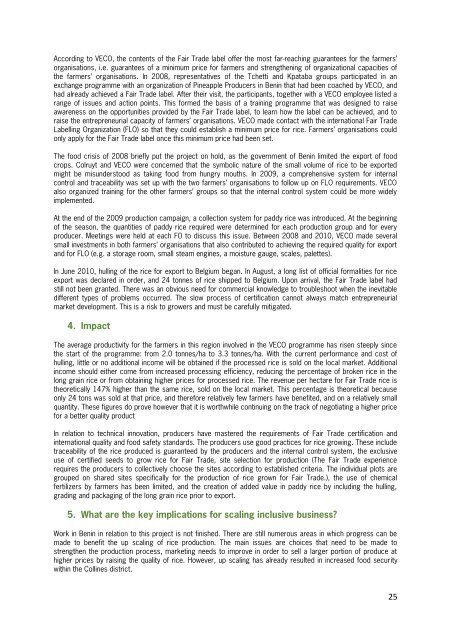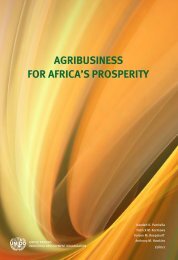Collection of Case Studies 2. - Seas of Change Initiative
Collection of Case Studies 2. - Seas of Change Initiative
Collection of Case Studies 2. - Seas of Change Initiative
You also want an ePaper? Increase the reach of your titles
YUMPU automatically turns print PDFs into web optimized ePapers that Google loves.
According to VECO, the contents <strong>of</strong> the Fair Trade label <strong>of</strong>fer the most far-reaching guarantees for the farmers’organisations, i.e. guarantees <strong>of</strong> a minimum price for farmers and strengthening <strong>of</strong> organizational capacities <strong>of</strong>the farmers’ organisations. In 2008, representatives <strong>of</strong> the Tchetti and Kpataba groups participated in anexchange programme with an organization <strong>of</strong> Pineapple Producers in Benin that had been coached by VECO, andhad already achieved a Fair Trade label. After their visit, the participants, together with a VECO employee listed arange <strong>of</strong> issues and action points. This formed the basis <strong>of</strong> a training programme that was designed to raiseawareness on the opportunities provided by the Fair Trade label, to learn how the label can be achieved, and toraise the entrepreneurial capacity <strong>of</strong> farmers’ organisations. VECO made contact with the international Fair TradeLabelling Organization (FLO) so that they could establish a minimum price for rice. Farmers’ organisations couldonly apply for the Fair Trade label once this minimum price had been set.The food crisis <strong>of</strong> 2008 briefly put the project on hold, as the government <strong>of</strong> Benin limited the export <strong>of</strong> foodcrops. Colruyt and VECO were concerned that the symbolic nature <strong>of</strong> the small volume <strong>of</strong> rice to be exportedmight be misunderstood as taking food from hungry mouths. In 2009, a comprehensive system for internalcontrol and traceability was set up with the two farmers’ organisations to follow up on FLO requirements. VECOalso organized training for the other farmers’ groups so that the internal control system could be more widelyimplemented.At the end <strong>of</strong> the 2009 production campaign, a collection system for paddy rice was introduced. At the beginning<strong>of</strong> the season, the quantities <strong>of</strong> paddy rice required were determined for each production group and for everyproducer. Meetings were held at each FO to discuss this issue. Between 2008 and 2010, VECO made severalsmall investments in both farmers’ organisations that also contributed to achieving the required quality for exportand for FLO (e.g. a storage room, small steam engines, a moisture gauge, scales, palettes).In June 2010, hulling <strong>of</strong> the rice for export to Belgium began. In August, a long list <strong>of</strong> <strong>of</strong>ficial formalities for riceexport was declared in order, and 24 tonnes <strong>of</strong> rice shipped to Belgium. Upon arrival, the Fair Trade label hadstill not been granted. There was an obvious need for commercial knowledge to troubleshoot when the inevitabledifferent types <strong>of</strong> problems occurred. The slow process <strong>of</strong> certification cannot always match entrepreneurialmarket development. This is a risk to growers and must be carefully mitigated.4. ImpactThe average productivity for the farmers in this region involved in the VECO programme has risen steeply sincethe start <strong>of</strong> the programme: from <strong>2.</strong>0 tonnes/ha to 3.3 tonnes/ha. With the current performance and cost <strong>of</strong>hulling, little or no additional income will be obtained if the processed rice is sold on the local market. Additionalincome should either come from increased processing efficiency, reducing the percentage <strong>of</strong> broken rice in thelong grain rice or from obtaining higher prices for processed rice. The revenue per hectare for Fair Trade rice istheoretically 147% higher than the same rice, sold on the local market. This percentage is theoretical becauseonly 24 tons was sold at that price, and therefore relatively few farmers have benefited, and on a relatively smallquantity. These figures do prove however that it is worthwhile continuing on the track <strong>of</strong> negotiating a higher pricefor a better quality productIn relation to technical innovation, producers have mastered the requirements <strong>of</strong> Fair Trade certification andinternational quality and food safety standards. The producers use good practices for rice growing. These includetraceability <strong>of</strong> the rice produced is guaranteed by the producers and the internal control system, the exclusiveuse <strong>of</strong> certified seeds to grow rice for Fair Trade, site selection for production (The Fair Trade experiencerequires the producers to collectively choose the sites according to established criteria. The individual plots aregrouped on shared sites specifically for the production <strong>of</strong> rice grown for Fair Trade.), the use <strong>of</strong> chemicalfertilizers by farmers has been limited, and the creation <strong>of</strong> added value in paddy rice by including the hulling,grading and packaging <strong>of</strong> the long grain rice prior to export.5. What are the key implications for scaling inclusive business?Work in Benin in relation to this project is not finished. There are still numerous areas in which progress can bemade to benefit the up scaling <strong>of</strong> rice production. The main issues are choices that need to be made tostrengthen the production process, marketing needs to improve in order to sell a larger portion <strong>of</strong> produce athigher prices by raising the quality <strong>of</strong> rice. However, up scaling has already resulted in increased food securitywithin the Collines district.25







